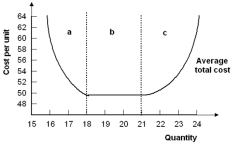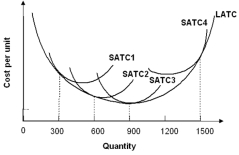A) $1.
B) $5.
C) $25.
D) $25/Q.
E) unknown.
Correct Answer

verified
Correct Answer
verified
Multiple Choice
Sidney Crosby's economic rent from playing hockey in the NHL is equal to the difference between his
A) initial offer and his final salary.
B) initial offer and his team's initial offer.
C) final salary and the least he would be willing to accept to play in the NHL.
D) final salary and the average for players in the NHL.
E) final salary and his team's initial offer.
Correct Answer

verified
C
Correct Answer
verified
Multiple Choice
Barriers to entry are
A) always legal in nature.
B) advantageous to firms but never harm consumers.
C) always economic in nature.
D) advantageous to consumers but always harm firms.
E) constraints,legal,economic,or otherwise that limit the movement of resources.
Correct Answer

verified
Correct Answer
verified
Multiple Choice
If the owners of a business are receiving total revenue sufficient to cover all their explicit and implicit costs,they are
A) earning positive economic profit.
B) earning a normal profit.
C) earning economic losses.
D) doing better than their next-best alternative.
E) doing worse than their next-best alternative.
Correct Answer

verified
B
Correct Answer
verified
Multiple Choice
If economic profit is negative but accounting profit is positive,then
A) accounting profit is less than implicit costs.
B) total revenue is greater than the sum of explicit and implicit costs.
C) explicit costs exceed total revenue.
D) normal profit is zero.
E) explicit costs equal implicit costs.
Correct Answer

verified
Correct Answer
verified
Multiple Choice
Superstar professional athletes can sustain their economic rents because
A) team owners will pay anything to win the championship.
B) they have excellent union representation.
C) they are greedy and spoiled.
D) if their current team does not pay,they can take their unique talents to another team willing to pay.
E) their opportunity costs of playing are high.
Correct Answer

verified
Correct Answer
verified
Multiple Choice
If firms are exiting a perfectly competitive industry,this suggests that
A) economic profit is zero.
B) accounting profit is zero.
C) accounting profit is negative.
D) there is normal profit.
E) economic profit is negative.
Correct Answer

verified
Correct Answer
verified
Multiple Choice
Generally,______ motivate firms to enter an industry,while ______ motivate firms to exit an industry.
A) economic profits;economic losses
B) accounting profits;accounting losses
C) accounting profits;economic losses
D) economic profits;accounting losses
E) normal profits;normal losses
Correct Answer

verified
A
Correct Answer
verified
Multiple Choice
 -Refer to the diagram above.The firm is experiencing diseconomies of scale when output is
-Refer to the diagram above.The firm is experiencing diseconomies of scale when output is
A) less than 18 units.
B) between 18 and 21 units.
C) greater than 21 units.
D) greater than 18 units.
E) less than 21 units.
Correct Answer

verified
Correct Answer
verified
Multiple Choice
Right Panel: The market: a shift of short-run supply in response to an increase in demand.  -Refer to the diagrams above.If the market demand for wheat and the market supply of wheat are represented by D and SRS,respectively,the firm will charge ___ per bushel and produce ____thousand bushels of wheat per year.
-Refer to the diagrams above.If the market demand for wheat and the market supply of wheat are represented by D and SRS,respectively,the firm will charge ___ per bushel and produce ____thousand bushels of wheat per year.
A) $1.10;10
B) $1.10;12
C) $1.12;12
D) $1.20;10
E) $1.20;12
Correct Answer

verified
Correct Answer
verified
Multiple Choice
 -Refer to the diagram above.The firm is experiencing economies of scale when output is
-Refer to the diagram above.The firm is experiencing economies of scale when output is
A) less than 18 units.
B) between 18 and 21 units.
C) greater than 21 units.
D) greater than 18 units.
E) less than 21 units.
Correct Answer

verified
Correct Answer
verified
Multiple Choice
The value of income received by a firm in return for supplying goods and services is called
A) economic rent.
B) revenue.
C) accounting profit.
D) economic profit.
E) normal profit.
Correct Answer

verified
Correct Answer
verified
Multiple Choice
 -Refer to the graph above.If a firm was originally producing on SATC3 but now desires to reduce its output to 600 units,in the short run it will use the plant size represented by
-Refer to the graph above.If a firm was originally producing on SATC3 but now desires to reduce its output to 600 units,in the short run it will use the plant size represented by
A) SATC1.
B) SATC2.
C) SATC3.
D) SATC4.
E) SATC2 and SATC3.
Correct Answer

verified
Correct Answer
verified
Multiple Choice
If accounting profit is positive,then
A) economic profit is also positive.
B) economic profit is either zero or positive.
C) the firm is receiving a normal profit.
D) economic profit can be negative,zero,or positive.
E) new firms must be entering the industry.
Correct Answer

verified
Correct Answer
verified
Multiple Choice
Right Panel: The market: a shift of short-run supply in response to an increase in demand.  -Refer to the diagrams above.If the market demand for wheat and the market supply of wheat are represented by D and SRS,respectively,the total costs of the firm at the profit-maximizing output are equal to
-Refer to the diagrams above.If the market demand for wheat and the market supply of wheat are represented by D and SRS,respectively,the total costs of the firm at the profit-maximizing output are equal to
A) $1.10.
B) $1.20.
C) $11.
D) $11,000.
E) 10,000 bushels.
Correct Answer

verified
Correct Answer
verified
Multiple Choice
Right Panel: The market: a shift of short-run supply in response to an increase in demand.  -Refer to the diagrams above.If the market demand for wheat and the market supply of wheat are represented by D' and SRS,respectively,the firm is making a profit of
-Refer to the diagrams above.If the market demand for wheat and the market supply of wheat are represented by D' and SRS,respectively,the firm is making a profit of
A) $0.20.
B) $0.80.
C) $240.
D) $960.
E) $1,000.
Correct Answer

verified
Correct Answer
verified
Multiple Choice
A firm earning a normal profit
A) should exit the industry.
B) will shut down.
C) has no incentive to leave the industry.
D) is covering explicit costs but not implicit costs.
E) is covering implicit costs but not explicit costs.
Correct Answer

verified
Correct Answer
verified
Multiple Choice
Economic profit is
A) the same as accounting profit.
B) equal to total revenue minus the sum of fixed and variable costs.
C) equal to total revenue minus both explicit and implicit costs.
D) greater than accounting profit.
E) only important to economists.
Correct Answer

verified
Correct Answer
verified
Multiple Choice
Suppose that Robert is willing to work for $10 per hour and receives an offer of $15 per hour.Robert's
A) economic profit is $5 per hour.
B) economic rent is $5 per hour.
C) economic rent is $15 per hour.
D) economic profit is $15 per hour.
E) economic rent is $10 per hour.
Correct Answer

verified
Correct Answer
verified
Multiple Choice
Harvey quit his job at the University of Toronto where he earned $45,000 a year,the same as other employees of normal ability,the same as other employees of normal ability.But Harvey is unusually talented in another area,and he figures his entrepreneurial talent,or forgone entrepreneurial income,to be $5000 a year.He cashed in $100,000 in bonds that earned 10% interest annually to buy a software company,Extreme Gaming.In the first year,the firm sold 11,000 units of software at $75 per unit.Of the $75 per unit,$55 goes for the costs of production,packaging,marketing,employee wages and benefits,and rent on a building. -Refer to the above information.If the price of the product increases to $85,then the economic profit will be
A) $60,000.
B) $220,000.
C) $270,000.
D) $330,000.
E) $250,000.
Correct Answer

verified
Correct Answer
verified
Showing 1 - 20 of 114
Related Exams